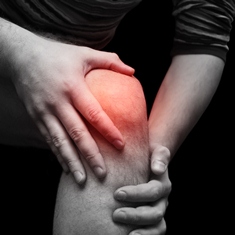Health Blog: Solutions & Wellness Tips
Full-scale Evaluation Of Various Treatments For Knee Osteoarthritis

Knee osteoarthritis: a debilitating and costly concern
Osteoarthritis (OA), a condition characterized by the breakdown of articular joint cartilage, occurs most frequently in the knee where it's a major source of pain and disability. Patients with knee OA consequently experience an inability to perform activities of daily living and their quality of life (QoL) is also negatively affected. Today, more than 30% of adults over the age of 60 experience functional limitations due to knee OA, with health care costs related to the condition estimated at $60 billion annually. By 2020, it's estimated that 11.6 million people will experience limitations due to the disease, making treatment of knee OA a serious priority. There are currently a number of treatments options available for knee OA (arthroscopic surgery, knee capsule injections, non-steroidal anti-inflammatory drugs [NSAIDs]) but few have proven to be as effective as physical therapy. Since the risk of knee OA is so high in aging adults, it's imperative that physical therapists have a complete understanding of the available treatment methods and which ones are most effective. To address this concern, a systematic review was created to review current trends for treatment of knee OA and to compare the effectiveness of each intervention.
Appropriately categorizing each applicable study
A number of reputable databases were searched for studies pertinent to the focus of the review. Only studies that were peer-reviewed, published between 1996-2007 and consisting of a control group were considered for inclusion. The quality of each study was determined by the rating system of Sackett's five levels of evidence, which allows for three grades of recommendations:
Level I: Studies consisting of randomized controlled trials (RCTs) with sample size of 100 or more subjects and low incidence of false-positive and false-negative errors
Level II: " RCTs with sample size of less than 100 and high incidence of false-positive and false-negative errors
Level III: " non-randomized, concurrent, cohort comparisons between subjects that did not receive treatment
Level IV: " non-randomized, historical, cohort comparisons between current subjects who did receive treatment and former subjects who did not
Level V: " case series without control
Recommendations were subsequently broken down using this system: grade A recommendations were supported by at least one level I study, grade B were supported by at least one level II study, and grade C were supported by any combination of levels III, IV or V studies.
Ample number of studies produces clear-cut set of recommendations
A total of 22 studies were found in the databases that were relevant to the subject matter, and after using the inclusion criteria, 15 studies made the cut and were evaluated according to Sackett's. Of these, there were two level I trials, 12 level II trials, and two level V trials. The following recommendations were then created according to the findings of each study:
Grade A recommendations
1. Class-based exercise is more effective than home-based exercise to decrease the pain associated with knee OA.
2. True or electro acupuncture has been shown to relieve pain in patients with knee OA when compared to patients that receive sham acupuncture.
Grade B recommendations
1. Mechanical unloading using a Zuni Exercise System of patients with knee OA may not help with pain reduction.
2. The use of a neoprene brace and/or therapeutic tape on patients with knee OA may help reduce pain and regain function.
3. Patients that are treated in a clinic or classroom setting benefit more from exercise and manual therapy than those given instructions for home-based exercise.
4. Aquatic or hydrotherapy has positive effects on the strengthening of patients with knee OA.
5. Manual therapy and exercise is shown to increase quadriceps strength, while decreasing disability.
Grade C recommendations
1. An evidence-based exercise and health education program to inform patients of OA is useful in patient comprehension of the disease.
2. Stretching, strengthening exercise, and perturbations are all useful interventions for aging adults with knee OA.
In addition, there was a clear trend noticed in the studies that patients who received treatment from a physical therapist directly showed better scores on the Western Ontario and McMaster Osteoarthritis Knee Index (WOMAC) and had decreased pain when compared to those who didn't receive treatment. This means physical therapy should be considered an effective treatment option for knee OA, particularly when these recommendations are followed. As always, future studies are needed for additional support of physical therapy's effectiveness and to further investigate specific modalities, but for now, these recommendations should serve as a useful set of guidelines in helping physical therapists determine specific treatment programs for patients with knee OA.
-As reported in the spring '09 edition of the Journal of Geriatric Physical Therapy
September 27, 2012
Back to Health BlogRECENT POSTS
- Exercise Therapy May Provide Relief for Chemotherapy-Related Issues
- Unlocking Relief From Elbow Pain With Hands-On Therapy and Exercise
- Are Deep Squats Really as Bad as We Think?
- Reclaiming Your Grip: The Power of Hands-On Therapy for Tennis Elbow
- Runners Can Overcome a Common Knee Condition With Physical Therapy
- How Physical Therapy Can Help Older Adults Stay on Their Feet
- What You Need to Know About Alcohol and Heart Health
- Exercise Therapy Provides Strong Evidence of Its Effectiveness
- Strength in Age: The Power of Resistance Training for Older Adults
- Hip Strength and Groin Pain: What Athletes Need to Know
